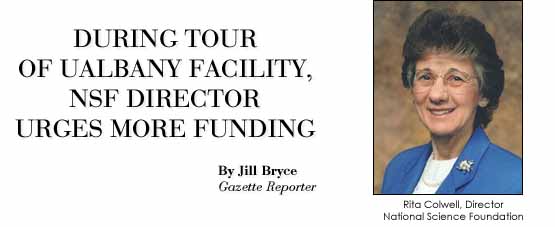

(Reproduced courtesy of The Gazette Newspapers)ALBANY — The director of the National Science Foundation said Monday the organization needs more funding that can be directed to science and technology research that will help shape the future.
Rita Colwell, a microbiologist who was appointed director of the NSF in 1998, made her case for funding during a visit Monday to the University at Albany. She called it the "most critical message" she could give.
This year Colwell has worked with President Clinton and proposed a 17.2 percent increase in next year's budget for the National Science Foundation. The organization, an independent agency of the federal government, was formed in 1950 and is responsible for promoting basic research and education in the sciences. It has a $4 billion budget.
Colwell said it's interesting to compare the NSF budget to other organizations' budgets, like the National Institute of Health, $18 billion; NASA, $13 billion; and the Department of Energy, $13 billion.
The NSF has such a small budget because scientists in general argue for funding for their individual areas — physicists seek funding for physics while chemists are interested in chemistry research.
The proposed 17.3 percent funding increase will allow the NSF to invest in basic disciplines, said Colwell. "We cannot have advances in medicine without advances in chemistry," she said, adding that many advances come out of research funded by the NSF.
Magnetic Resonance Imaging came from physics research funded by the NSF, for example, as did many other medical advances. Other advances rooted in physics and funded by the NSF include laser research and Doppler radar, she said. Even Internet search engines were based on research funded by the NSF.
"The National Science Foundation allows pure, basic research. It's sad the NSF budget has not increased proportionately" to the rest of the federal budget, Colwell said.
NSF annual funding goes to 200,000 students and researchers at many levels from high school and college to graduate and postgraduate studies and is also granted to teachers.
"The National Science Foundation is to the science and technology work force what the National Institute of Health is to the medical work force. Without it, we would be in trouble. We would have to reinvent it."
Colwell said the future focus will be on interdisciplinary research, which combines science, chemistry, computer science, physics, molecular biology and material science. "I also feel very committed to mathematics. It has been criminally underfunded," Colwell said. The average NSF grant given for mathematics research is $25,000.
Dr. Alain E. Kaloyeros, director of the University at Albany's Center for Thin Film Technology, gave Colwell a tour of the university's advanced technology site for microelectronic, atmospheric science and software development, CESTM (Center for Environmental Sciences and Technology Management). During construction, the facility received $750,000 in funding from the NSF.
Colwell said she was very impressed with the facility. "This is first class, very, very impressive. It is what we need around the country. We need to bring science and technology to all parts of the country."
Kaloyeros agreed the NSF needs more funding. He said 15 to 20 years ago, the average NSF graduate grant was $65,000 to $70,000. Today, in constant dollars, it is less.
The University at Albany receives a substantial amount from the NSF. Christopher D'Elia, vice president for research at the university, said of the university's $110 million overall research budget, $10 million comes from the NSF.
"The NSF is crucial. It does so many things, funding research and people in careers. If we are going to be scientifically strong, we need to develop human resources."
D'Ella said it is important that New York's congressional delegates are solidly behind the NSF as the state sees a continuing shift from heavy industry to e-commerce.
Colwell's visit was part of the celebration of the 50th anniversary of the NSF.
Convocation Dinner Speech
NSF/UAlbany — Links Getting Stronger All the Time